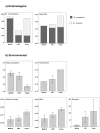Environmental factors associated with the malaria vectors Anopheles gambiae and Anopheles funestus in Kenya
- PMID: 19941637
- PMCID: PMC2793260
- DOI: 10.1186/1475-2875-8-268
Environmental factors associated with the malaria vectors Anopheles gambiae and Anopheles funestus in Kenya
Abstract
Background: The Anopheles gambiae and Anopheles funestus mosquito species complexes are the primary vectors of Plasmodium falciparum malaria in sub-Saharan Africa. To better understand the environmental factors influencing these species, the abundance, distribution and transmission data from a south-eastern Kenyan study were retrospectively analysed, and the climate, vegetation and elevation data in key locations compared.
Methods: Thirty villages in Malindi, Kilifi and Kwale Districts with data on An. gambiae sensu strict, Anopheles arabiensis and An. funestus entomological inoculation rates (EIRs), were used as focal points for spatial and environmental analyses. Transmission patterns were examined for spatial autocorrelation using the Moran's I statistic, and for the clustering of high or low EIR values using the Getis-Ord Gi* statistic. Environmental data were derived from remote-sensed satellite sources of precipitation, temperature, specific humidity, Normalized Difference Vegetation Index (NDVI), and elevation. The relationship between transmission and environmental measures was examined using bivariate correlations, and by comparing environmental means between locations of high and low clustering using the Mann-Whitney U test.
Results: Spatial analyses indicated positive autocorrelation of An. arabiensis and An. funestus transmission, but not of An. gambiae s.s., which was found to be widespread across the study region. The spatial clustering of high EIR values for An. arabiensis was confined to the lowland areas of Malindi, and for An. funestus to the southern districts of Kilifi and Kwale. Overall, An. gambiae s.s. and An. arabiensis had similar spatial and environmental trends, with higher transmission associated with higher precipitation, but lower temperature, humidity and NDVI measures than those locations with lower transmission by these species and/or in locations where transmission by An. funestus was high. Statistical comparisons indicated that precipitation and temperatures were significantly different between the An. arabiensis and An. funestus high and low transmission locations.
Conclusion: These finding suggest that the abundance, distribution and malaria transmission of different malaria vectors are driven by different environmental factors. A better understanding of the specific ecological parameters of each malaria mosquito species will help define their current distributions, and how they may currently and prospectively be affected by climate change, interventions and other factors.
Figures


References
-
- Gillies MT, De Meillon B. The Anophelinae of Africa South of the Sahara. South African Institute for Medical Research. 1968;54:127–150.
Publication types
MeSH terms
Substances
LinkOut - more resources
Full Text Sources

